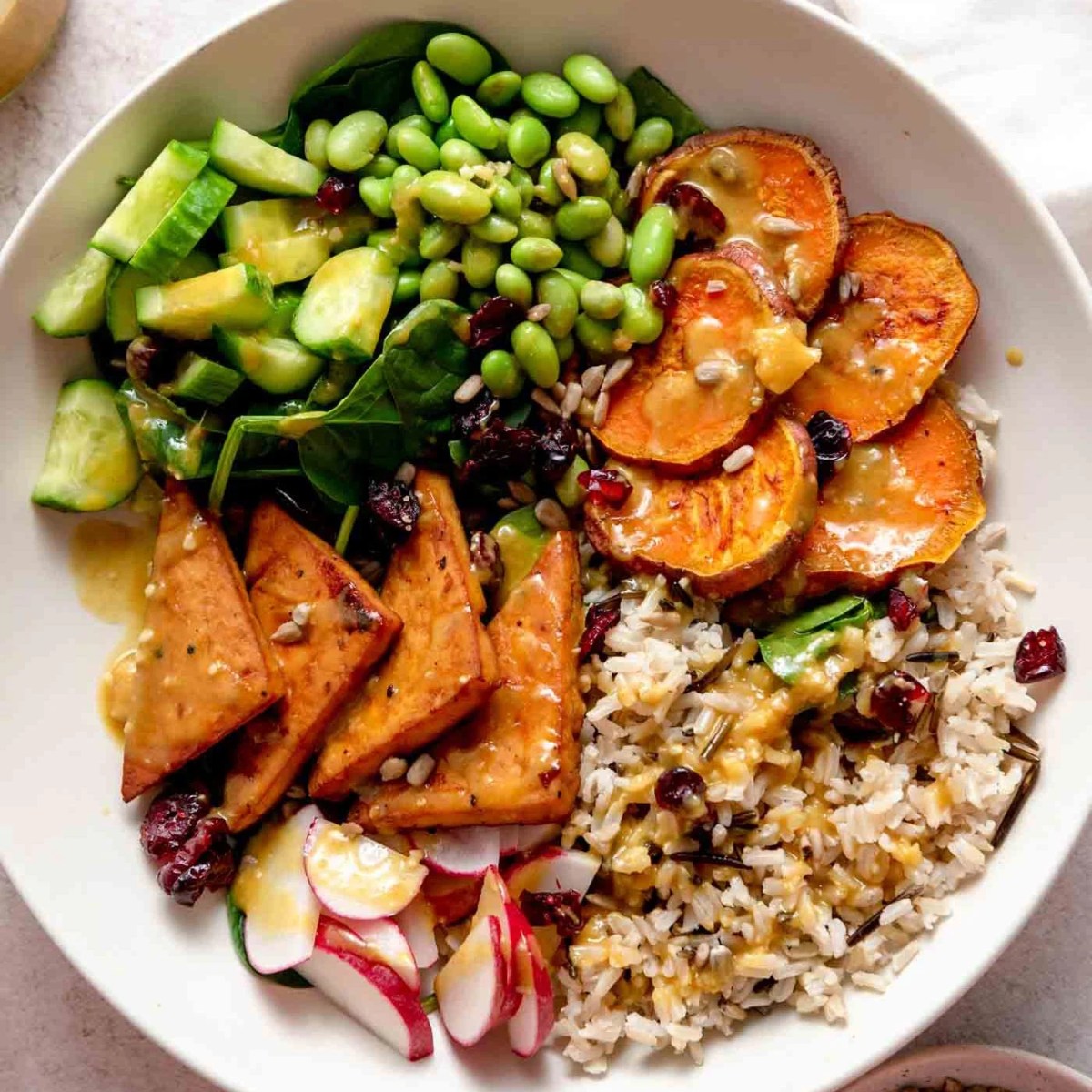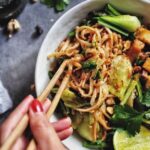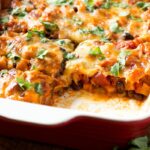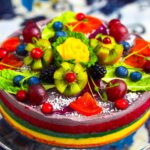Unleash your inner chef and embark on a culinary journey to create the ultimate vegetarian power bowl! Imagine vibrant colors bursting from a bowl brimming with wholesome ingredients, each bite a symphony of textures and flavors. This isn’t just a meal; it’s a vibrant masterpiece crafted from carefully selected proteins, grains, and seasonal vegetables, expertly seasoned and artfully arranged. Prepare to discover the secrets to building a power bowl that’s as nourishing as it is visually stunning.
From choosing the perfect protein source – be it lentils bursting with fiber, quinoa brimming with protein, or black beans delivering a creamy texture – to mastering the art of roasting vegetables to bring out their natural sweetness, this guide provides a step-by-step approach. We’ll explore diverse flavor profiles, from the bright zing of a Mediterranean bowl to the earthy warmth of an Asian-inspired creation, offering adaptable recipes to suit every palate and dietary need. Get ready to elevate your vegetarian meals to a whole new level.
Ingredient Selection & Preparation
Power bowls are a fantastic way to create a vibrant and nutritious meal. The key to a truly exceptional power bowl lies in the careful selection and preparation of its ingredients. Choosing high-quality, flavorful components and prepping them correctly will elevate your bowl from good to unforgettable.
Versatile Vegetarian Protein Sources
Selecting a diverse range of protein sources is crucial for a well-rounded and satisfying vegetarian power bowl. These proteins provide essential amino acids, fiber, and other vital nutrients, contributing to satiety and overall health.
- Lentils: These tiny legumes pack a powerful nutritional punch, boasting high levels of protein and fiber. Their earthy flavor complements a wide array of vegetables and grains. Prepare them by rinsing thoroughly and cooking according to package directions, usually simmering for 20-30 minutes until tender.
- Black Beans: Another excellent source of protein and fiber, black beans offer a creamy texture and slightly sweet flavor. They are readily available canned, requiring only a quick rinse before use. For a more intense flavor, consider simmering them with some aromatics like onions and garlic.
- Tofu: This versatile soy product is a blank canvas for flavor, readily absorbing the tastes of marinades and sauces. Crumble it for a texture similar to ground meat, or press and cube it for a firmer bite. Pan-frying or baking tofu until golden brown enhances its flavor and texture.
- Chickpeas: These legumes are incredibly versatile, functioning well as a base for hummus, a hearty addition to salads, or roasted until crispy for a satisfying crunch in your bowl. Rinse canned chickpeas thoroughly or soak and cook dried chickpeas for a longer, more flavorful result.
- Quinoa: While often categorized as a grain, quinoa is technically a complete protein, meaning it contains all nine essential amino acids. Its slightly nutty flavor and fluffy texture make it a perfect base for power bowls. Rinse thoroughly before cooking according to package directions.
Vegetable Preparation Techniques
Proper vegetable preparation is paramount for achieving optimal flavor and texture in your power bowl. Different vegetables require different approaches to maximize their deliciousness.
For crisp vegetables like bell peppers, cucumbers, and carrots, a sharp knife and precise chopping are key. Aim for consistent, bite-sized pieces for even cooking and pleasant eating. Leafy greens like spinach or kale can be roughly chopped or even added raw for a vibrant pop of color and nutrients. Root vegetables like sweet potatoes or beets benefit from roasting, which caramelizes their sugars and intensifies their flavor. Roasting involves tossing the chopped vegetables with olive oil, herbs, and spices, then baking at a high temperature until tender and slightly browned.
Grain Cooking Comparison
| Grain | Cooking Time (approx.) | Nutritional Highlights | Texture |
|---|---|---|---|
| Quinoa | 15 minutes | Complete protein, high in fiber and iron | Fluffy, slightly nutty |
| Brown Rice | 45-50 minutes | Good source of fiber, magnesium, and manganese | Chewy, slightly firm |
| Farro | 40-45 minutes | High in fiber, protein, and several minerals | Chewy, nutty, pearl-like |
Presentation and Serving Suggestions

A visually stunning vegetarian power bowl isn’t just about delicious ingredients; it’s about creating a culinary masterpiece that tantalizes the senses before the first bite. The artful arrangement of colors, textures, and heights elevates the entire dining experience, transforming a simple meal into a celebration of vibrant flavors. A well-presented power bowl invites the diner to engage with the food on a deeper level, appreciating the careful consideration that went into its creation.
The key to a captivating power bowl lies in thoughtful arrangement. Imagine a canvas, and your bowl is the frame. Start by building a foundation of grains or larger vegetables like roasted sweet potatoes, creating a stable base. Then, strategically layer colorful components – vibrant reds from roasted peppers, deep greens from spinach or kale, and sunny yellows from corn or squash. Varying the heights of your ingredients adds visual interest and depth. Consider placing taller elements like sprouts or toasted nuts towards the edges to create a sense of movement and avoid a monotonous flat presentation. Think about contrasting colors and textures – a smooth avocado against crunchy chickpeas, for example – to make the bowl more dynamic and visually appealing.
Complementary Toppings for Enhanced Visual Appeal and Flavor
Adding the right toppings is crucial in enhancing both the visual and gustatory experience. The careful selection of toppings can transform a good power bowl into a truly unforgettable one. Consider these options to elevate your creation:
- Toasted pumpkin seeds: Their vibrant green hue contrasts beautifully against other ingredients, adding a pop of color. Their crunchy texture provides a delightful textural contrast to softer elements like quinoa or avocado. Imagine the speckled green seeds scattered across a bed of crimson roasted red peppers.
- Sliced toasted almonds: These offer a warm, nutty flavor and a pleasingly crisp texture. Their pale color provides a subtle contrast while their shape adds visual interest. Picture slender, golden-brown almond slivers elegantly strewn across the bowl.
- Fresh cilantro: The bright, vibrant green of fresh cilantro adds a refreshing pop of color and a zesty, herbaceous note. Its delicate leaves create a sense of lightness and airiness. Imagine a scattering of feathery cilantro sprigs contrasting against the deeper greens and earthy tones of the other ingredients.
- Hemp seeds: These tiny, earthy seeds offer a subtle nutty flavor and a slightly chewy texture. Their dark green-brown color adds depth and visual interest, particularly against lighter-colored ingredients. Envision a sprinkling of these tiny seeds creating a textured pattern across the surface of the bowl.
- Dried cranberries: These offer a sweet-tart flavor and a pleasingly chewy texture. Their deep ruby red color adds a splash of vibrant color, creating a striking contrast against the other ingredients. Imagine the jewel-toned cranberries scattered throughout the bowl, adding a burst of color and flavor.
Creating the perfect vegetarian power bowl is more than just assembling ingredients; it’s an art form that blends nutrition, flavor, and visual appeal. By mastering the techniques Artikeld in this guide – from selecting the ideal base to adding exciting textures and vibrant toppings – you’ll be empowered to craft personalized power bowls that are as unique as you are. Each bowl becomes a testament to your culinary creativity, a satisfying and healthy meal that nourishes both body and soul. So, gather your ingredients, unleash your creativity, and prepare to be amazed by the delicious results!
Essential FAQs
Can I make vegetarian power bowls ahead of time?
Absolutely! Prepare the base and components separately, then assemble just before serving to maintain optimal freshness and texture. Store components in airtight containers in the refrigerator for up to 3 days.
What are some good substitutes for quinoa?
Excellent alternatives include brown rice, farro, couscous, or freekeh. Each offers a unique texture and nutritional profile.
How can I make my power bowl more filling?
Add more grains or legumes to increase the volume and protein content. Consider incorporating roasted chickpeas or adding a dollop of nut butter for extra healthy fats and satiety.
Are there any tips for making vegetarian power bowls kid-friendly?
Involve your children in the preparation process! Let them choose their favorite vegetables and toppings. Cut ingredients into fun shapes using cookie cutters. Serve with a dip or dressing on the side.


